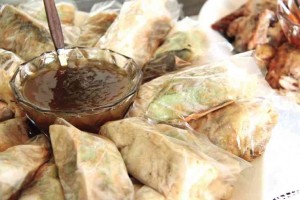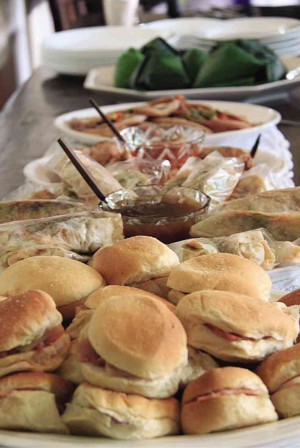
All my life, I have been in awe of Quiapo and its sights, sounds, flavors… To me, Quiapo best exemplifies who we are—blessed with a glorious past, culturally rich, colorful, diverse, timeless.
Yearning to revisit Quiapo, I called a dear friend, Carlos Celdran, to show me around. Together with a bunch of my students, we walked, shopped, cooked and ate our way through the district which, Carlos said, is the heart and soul of Manila.
The Nakpil-Bautista house at 432 A. Bautista (formerly Barbosa Street) was our meeting place where we were welcomed by Bobbi Nakpil Santos-Viola, president of Bahay Nakpil-Bautista Foundation Inc., and her nephew Dominic.
Bobbi said the house, a landmark in Quiapo, was built by Dr. Ariston Bautista and his wife Petrona Nakpil. The childless couple invited Petrona’s brothers and sisters to live with them.
One of her brothers was Julio Nakpil, a Katipunero and musical composer who was commissioned by supremo Andres Bonifacio to write a draft for the Philippine national anthem. Nakpil eventually married Andres Bonifacio’s widow, Gregoria de Jesus.
We learned that Dr. Bautista loved to entertain. It was said the Bahay Nakpil-Bautista was constantly alive with parties—opera music played by an orchestra, and delicious food served on

fine china and crystal.
From Bahay Nakpil-Bautista, we set out to explore Quiapo by foot. Passing through candle vendors, Carlos took us to the side entrance of Minor Basilica of the Black Nazarene, more famous as Quiapo Church, where we paid our respects and prayed to the Nazareno.
Cheaper by the ‘tumpok’
From there we experienced Quiapo from a foodie perspective—filling our bayong with items like there’s no tomorrow. Everything here was cheaper by the tumpok: the colorful peppers, the huge kalamansi, the vegetables, the dried fish, everything was laid out beautifully for the picking.
We also sampled its yummy delights, served in locations that are landmarks themselves:
Globe Lumpia House. Opened in 1953 along Quezon Boulevard, the place moved three years later to Raon (now Gonzalo Puyat Street) at the old Globe Theater, thus the name Globe Lumpia House.
According to its proprietor, Reynaldo Lantin, the recipe for the lumpia was taught to his grandfather by his great grandmother in China. As tradition would have it, the recipe is handed down only to the sons, since the daughters will eventually leave to be with their husbands.
Lantin attributes the lumpia’s popularity to the freshest ingredients and selling it at the lowest possible price (as his lolo often reminded the clan). From 20 centavos in 1953, it now costs P16, still cheap.
Excelente Ham. Opened in 1963, its one and only store is still at 155-157 Carlos Palanca Street (formerly Echague). Needless to say, its ham still reigns supreme! Its delectable pineapple ham, eaten as palaman in Vienna Bakery pan de sal, makes the perfect Quiapo merienda experience.
Kim Chong Tin Hopia Factory. Located right beside Excelente Ham, it is home to the best hopia in town, still made by hand and baked in pugon.
The story goes that Ong Pei Pee, an orphan, migrated to the Philippines from China and worked as a houseboy for a family that sold hopia. He learned how to make the pastry himself and, after saving enough money from his salary, opened his own hopia store in 1927.
His grandson Kiko Ong, who is now in charge of the store, said perseverance, luck and devotion to the Nazareno are the reasons why the family business continues to flourish.
My personal favorites are hopiang mongo with salted egg, condol with bacon, and condol with pork. I’ve been back to Quiapo three times since, because I’ve been craving for this hopia—flaky with smooth and creamy centers that are really tasty.
We dared not miss the specialties of Muslim Quiapo such as Arab Spice Chicken at Moud Halal Restaurant (829 Globo de Oro St.); Pater Rice (flaked flavorful chicken over rice for P10) and fish eggs and balbacua (bulalo cooked with turmeric) at Junairah Halal Restaurant also at Globo de Oro Street.
Two hours later we went back to Bahay Nakpil-Bautista where I cooked a couple of dishes from ingredients we found during our stroll—tinola made with turmeric and palapa (spice paste from the Muslim market) and fried rice scented with dried tuna, which I bought beside the palapa vendor.
Pinatisang Alimango
The culinary treat was made complete by an heirloom recipe from the Nakpil family: Lola’s Pinatisang Alimango cooked by Dominic Faustino. He said the dish was Gregoria de Jesus’
favorite, the recipe handed down to him by Mercedez Nakpil-Zialcita and her mayordoma Manang Lucha.
Ingredients:
- 3 live alimango (1 female, 2 male crabs)
- Dayap/calamansi/lemon
- 3 segments of macerated garlic
- ¼ c patis
1. Remove the crab shells covering the back; with your fingers, scoop out the aligue, and let it out into a clean bowl.
2. Scoop out the aligue from the bodies, but discard the black gelatinous substance. Wash each piece very well.
3. Cut each half into three between the appendages.
4. You may cut the tips of the appendages and discard them if you wish. Break the shells of the claws. Set aside all these pieces.
5. Strain the aligue, add 1½ cup water and keep on straining. Season with dayap juice and patis.
Cooking:
- Heat a kawali, pour ½ cup cooking oil. When warm enough, put in all the alimango pieces.
- Turn off the heat when the pieces are red. Remove all the pieces, set aside. Allow the oil to cool.
- Then warm the oil again, fry the garlic and pour in the previously prepared aligue sauce. Keep on stirring until it is cooked, then put in all the alimango pieces.
- Let simmer for about 30 minutes, and adjust the seasoning by adding either dayap juice or patis.
The Nakpil-Bautista kitchen needs to be restored. For those who have extra tiles, cement, wood, wires, etc. and wish to donate them to keep the grandeur of this heritage house of Quiapo alive, contact Bobbi Nakpil Santos-Viola at 0917-8517455 or 7319305.

